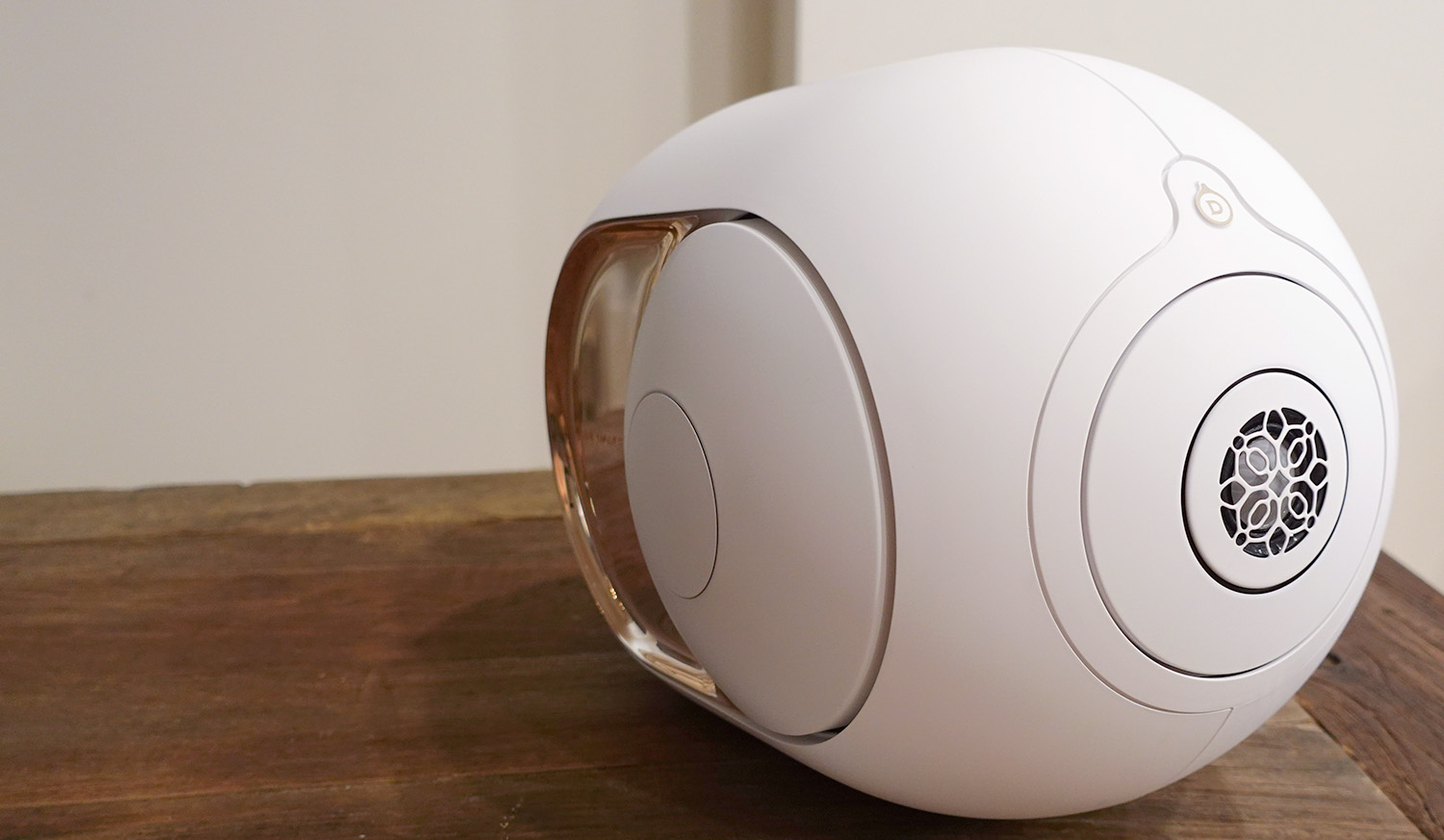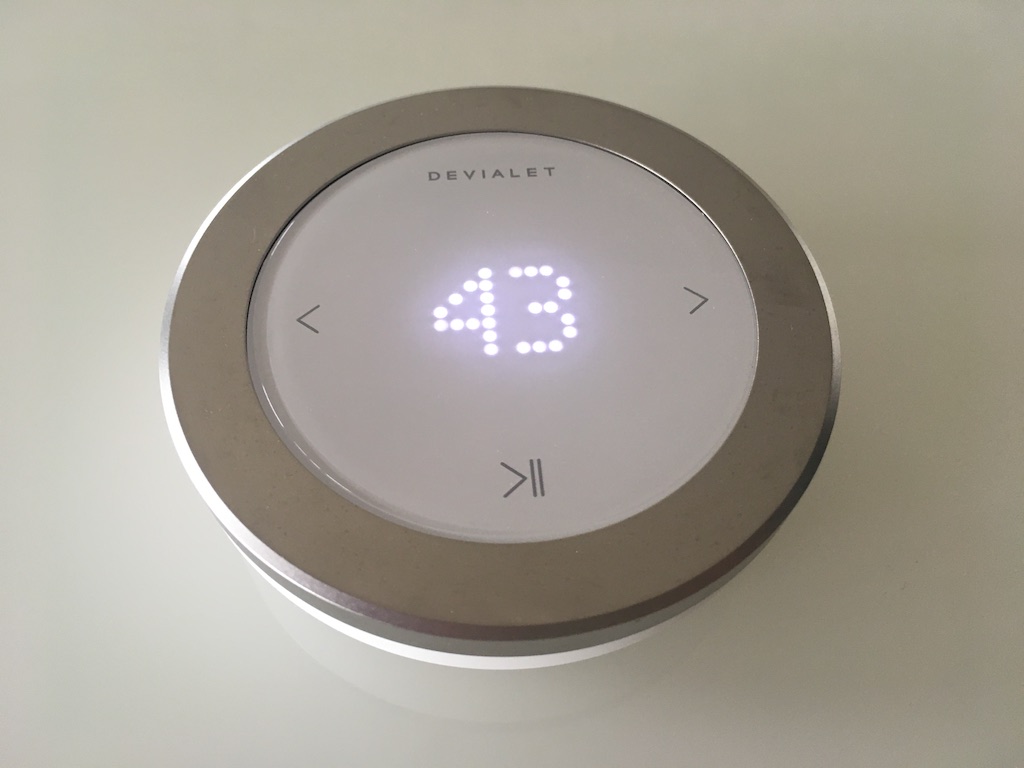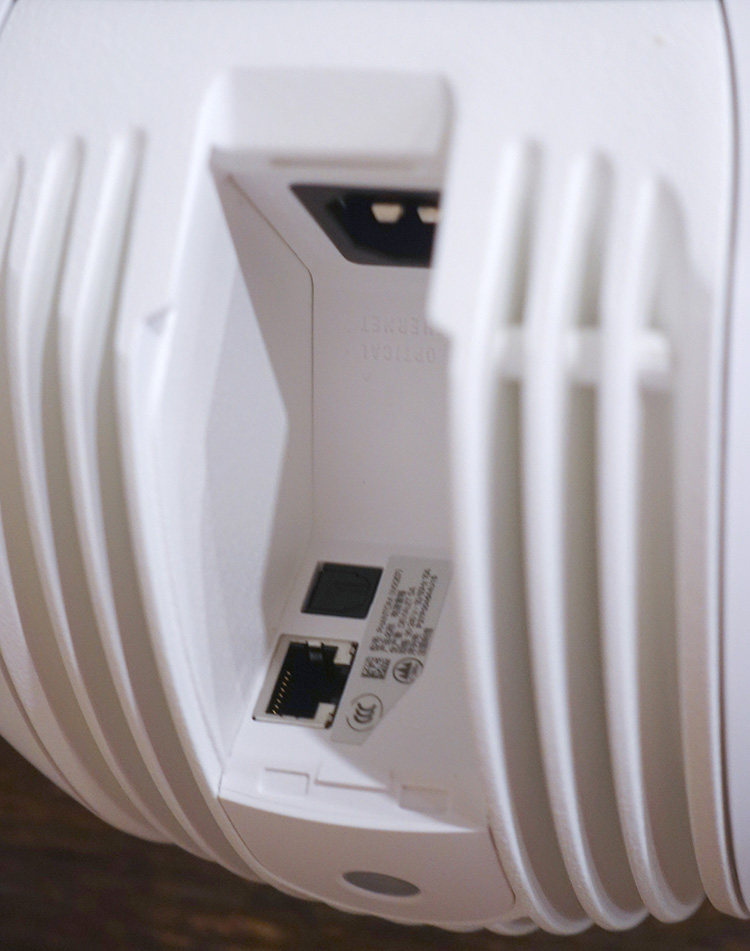 By any measure, the Devialet Phantom 1 is a beast of a powered speaker. Measuring a hefty 11 and a half kilograms, this French-made, orb-shaped behemoth promises audiophile-level quality, bone-thumping bass, room-filling amplification, and a galaxy of audio options, all emanating from a device that looks like it’s straight out of science fiction. So, does this unique deluxe speaker deliver?
By any measure, the Devialet Phantom 1 is a beast of a powered speaker. Measuring a hefty 11 and a half kilograms, this French-made, orb-shaped behemoth promises audiophile-level quality, bone-thumping bass, room-filling amplification, and a galaxy of audio options, all emanating from a device that looks like it’s straight out of science fiction. So, does this unique deluxe speaker deliver?
Specifications of the Phantom 1
The Devialet Phantom 1 108dB wireless multi-room speaker is available in Gold and Dark Chrome.
- Speaker build: Titanium Tweeter Driver, aluminum medium and bass drivers, side “dome driver” passive bass drivers
- DAC: 24bits/96hz capable “Devialet intelligence processor”
- O/S: Playback up to 24bit/48khz
- Processor: ARM Cortex-A9 @ 1.25GHZ, 512mb DDR3
- Width: 252mm | Height: 255mm | Depth: 242mm | Weight: 11.4kg
- Inputs: Ethernet, TOSLINK Optical
- Output: 108db SPL, 14Hz-27kHz, 1100 Watts RMS
- Streaming services/capabilities: Wi-Fi, Airplay 2, Bluetooth 5.0, Spotify Connect, UPnP, Optical, Roon
Unboxing the Devialet Phantom 1
The Devialet Phantom 1 is packed very well, housed in colourful outer cardboard with nested dividers inside. I feel as though this is done to securely wrap the round shape and to provide a sense of awe while “birthing” the unit from its packaging.
Handling the speaker is a bit precarious, as the sides are somewhat slippery and you have a tendency to want to press in on the front speaker or side passive transducers. The standard model doesn’t come with a stand, though a small tripod or full height speaker mount is available for those wanting such things at a further premium.

When placed on a table, a thick rubber ring on the bottom keeps it in place. Be cautious when moving it as the metal bracket used to connect to the optional stands comes dangerously close to scratching your countertop. Just lift it into place and you should be fine.
The side gold panels are made of fingerprint attracting glossy plastic, held in place by thick rubber thimble-like feet. Shifting the speaker around sometimes makes these side panels slip out, but they’re fairly straightforward to reorient. Setup was also fairly straightforward, and the downloaded app (available for both Android and iOS) does a decent job of getting you up and running.
Syncing the included remote control
 There is a round, wireless volume controller included with this model. Syncing it took a couple attempts, but after a few reboots of both the speaker and the remote, they successfully talked to one another and were locked in.
There is a round, wireless volume controller included with this model. Syncing it took a couple attempts, but after a few reboots of both the speaker and the remote, they successfully talked to one another and were locked in.
Devialet has a singular design
It seems clear that the aim of the Devialet Phantom is to be the most powerful wireless speaker you can buy, and its premium price indicates that they didn’t cut corners to achieve this performance.
The front lattice-shaped grill looks like the iris for this eye-shaped orb, sheltering the titanium and aluminum tweeter and mid-range drivers within. When the Phantom is used as a single, standalone speaker, the dispersion of the soundstage is quite remarkable, filling your entire room with sound. There is very low roll-off when you’re off-axis. In other words, you don’t need to be right in front to get decent sound, definitely one of the more remarkable parts of the speaker’s performance.
Connecting up the Devialet Phantom 1

There is a dedicated app for helping configure the Phantom, and it allows you to connect to a variety of streaming services and even network devices. While internally the specifications allow for higher resolution, there’s a cap of 24bit/48kHz sound when using their internal operating system.
For real-world use, the difference between “regular” streaming and high-resolution audio isn’t particularly evident on the Phantom. Even in a critical listening environment, a comparison on TIDAL between the Ogg/Vorbis stream and the “master”, 24bit was negligible at best. Streaming via Bluetooth from a high-end portable DAC also showed little in any difference between a lossy file and the high-resolution source.
Much of this likely has to do with the middling Bluetooth implementation, which while it supports Bluetooth 5.0 lacks either the AptX HD or LDAC, which provide superior lossless streaming capabilities.
Spotify Connect is a welcome addition to the Devialet Phantom
The implementation of Spotify Connect is a welcome one, meaning in that application on your phone you’re able to simply select the device rather than broadcast via Bluetooth and that allows you to stream via the Phantom’s own Wi-Fi connection. Unfortunately, you can’t do a pure Chromecast-style broadcast from Android devices for other services, meaning that for most things like YouTube, Amazon Music, TIDAL, etc., you’re restricted to using Bluetooth to stream.
Devialet Phantom 1 sound and performance
With its 100+ db amplification, the Phantom gets very, very loud, filling even the largest of rooms. It’s an impressive feat from such a small footprint, and it’s obvious why there are many fans of this product. Unfortunately, while there’s a more rich soundstage the louder it gets, the music ends up being all that more fatiguing, sounding a bit brittle and “plasticy”.
Testing the Phantom as a single source
Testing with a wide variety of music showcased its ability to pleasantly if not always convincingly reproduce a wide variety of music, from thumping electronica and hip hop to the more subtle and dynamic classical or acoustic Jazz tracks.
Mono tracks from Miles Davis’ iconic “Kind of Blue”, to “Taxman” from the Beatles’ extraordinary record Revolver, were the most satisfying songs I heard on the Phantom. While few modern recordings are designed for single speaker playback, this experiment did illustrate much better the capabilities of the unit, and perhaps provided even more evidence for needing a pair of Phantoms to truly get the most out of the solution.
When playing back wide stereo image songs (Steely Dan’s “Aja” is a fine if somewhat obvious exemplar) showed that no matter how powerful the sound, I feel as though you’re still missing out on the extra dimensionality provided by stereo playback. Some single speakers incorporate multiple drivers to simulate stereo, but here it always felt I was hearing the sound from a single point.
Sending test signals to the speakers illustrated that out of phase white noise managed to mostly cancel out to silence, as would be hoped, though there were still some noises that were heard as the side bass dome drivers rattled along, meaning that there’s not quite a perfect synchronization between all the internal elements.
In a smaller room, with the volume turned up, there was quite a bit of oomph that could be generated by the side transducers, and while it doesn’t mimic what similar-sized standalone speakers can do, it’s still quite the magic trick.
Unfortunately, it’s the warm, low-midrange information that seems to be missing, especially at a more moderate volume. You really notice the absence when listening to solo cello tracks from YoYo Ma, megastars like Adele, or Americana vocalists like Brandi Carlile and Alison Krauss.

Is the Devialet Phantom 1 right for you?
It’s clear the Phantom’s performance is significantly better than many of the often tinny, smaller models. However, given that it’s tethered to power and is not something you’re going to throw in your pack to take to the beach, the real competition in terms of sound alone is with both whole-home connected speakers and standalone systems with similarly robust amplification.
If you want to have some nice background music to set a mood that needs to fill up the space, or you have a large kitchen or living room that you want some tunes pumped into while other conversations are taking place, the Devialet Phantom 1 seems like an ideal solution. If you like the aesthetics of the speaker and you have the desire to avoid running unsightly cables, then this is absolutely a model you should be considering.
However, I have to note that even a modest two-channel setup would do nearly as well with playback at a fraction of the cost. By lacking analogue input, the Phantom 1 prevents the ability to connect turntables (save for via digitized TOSLINK), or superior digital sources that bypass internal processing. A simple 3.5mm analogue input would also do wonders to elevate the Phantom 1’s future-proofing, and would immediately increase its desirability.
Final take on the Devialet Phantom 1
At first glimpse the Devialet Phantom looks to check off all the boxes, promising high-fidelity sound reproduction in a small place, obviating the need for a standalone receiver solution to drive sounds wirelessly (save for the Phantom’s thick power lead) in even the largest of rooms. But the devil as always is in the details, and I found myself thinking about what the Phantom 1 couldn’t do more than what it was capable of. Inevitably, I kept coming back to the feeling that, in this case, form trumps function.
Given the same budget, one can find a capable two-channel setup that, while it won’t follow the same footprint, will be significantly more satisfying in terms of audio reproduction.
While the Devialet Phantom 1 may be one of the most powerful standalone, single speaker streaming music devices you can buy, if you’re looking for a serious replacement for a system built for dedicated listening, I think it’s missing a few key features. If you like the style of this speaker, then I recommend purchasing two to make up your system.
I applaud Devialet for pushing the envelope of what’s possible in such a product. You can find it right now at Best Buy.



